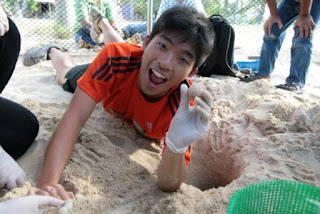A very good evening to all. It is now the end of day 3 of Project Orion II and we are happy to report that we are doing well. The first picture happens to be the very view that greets us every morning. With a view like that, it's pretty hard to start any day with a foul mood.

Today, the team went off to paint our second house. A couple of things we learned: Firstly, grooves in the planks aren't all that fun at all. Secondly, front porches are a pain in the neck and lastly, we work fast when we don't need to do the undercoating. Some of the team had to head off for other duties such as meeting with the school principal to iron out some details or heading into the city (45 minutes away) to make some necessary purchases so that effectively left about 6 of us to complete the paint job. Thankfully, we managed to get it all done. And as usual, the following are your customary before and after shots. Seriously, the difference is quite astounding; or so we think.


Just before dinner, the entire team was properly schooled in the sport of badminton by a 10 year-old. Not a single one of us managed to defeat him. Such interaction time with the village kids is always much appreciated. Not only are they innocent and adorable, they're also quite talented. Certainly not like the city kids we find these days; and I mean that in the best possible way.

At night, we had our first lesson with the village kids. Language differences may have caused some slight issues, but we were aided by the arrival of Brandon, a WWF youth officer, who kindly helped us out with key translations. Apart from teaching English to the children, we also helped them with their homework and enjoyed some games with them. I'm pretty sure we learnt as much from them as we hope they learned from us. There will be ongoing lessons for the next few nights and the team is really looking forward to them.
Additionally, tonight is also the night that we start our night patrols. The first three of us (Jia Wei, Ding Kun and Jason) are currently patrolling the beach at Telagan Papan. Luckily enough, they not only managed to collect what is reportedly one of the largest clutch of eggs ever (120 eggs), they also managed to actually see the Green Turtle laying eggs. Unfortunately enough, they had no video camera and no camera; so, we have no videos and no photos. Well done.
We also managed to release another batch of hatchlings tonight. All in all, that makes it 152 hatchlings we've helped to release. We hope earnestly that at least one of them will pay the beach a visit in 25 years to lay her own eggs.
The Malay word we've learnt for today is:
Lalat - Housefly (they're everywhere)
Last but not least, the catch of the day by Yong Liang is... not a chicken, but a duck. He promises to work on the chicken tomorrow. Simultaneously, the team has issued him with the ultimate challenge of catching a crocodile in Setiu River. Yea, good luck with that YL!
Evidently, that's all there is today. Keep viewing for more updates and do tell us what you want to read about. Also, please feel free to drop us a shout-out anytime. Thanks and good night!
Chow Wee
 We completed painting the house in an amazing time of 4 hours, I personally believe it's the experience we have gained along the way that allowed us to complete it. After painting, it is another episode of YongLiang's "catch of the day". Well, as promised I try to catch at least an animal daily, yup I have met "AH BU" the monkey which is being tied to the tree. (poor thing right.)
We completed painting the house in an amazing time of 4 hours, I personally believe it's the experience we have gained along the way that allowed us to complete it. After painting, it is another episode of YongLiang's "catch of the day". Well, as promised I try to catch at least an animal daily, yup I have met "AH BU" the monkey which is being tied to the tree. (poor thing right.)




































